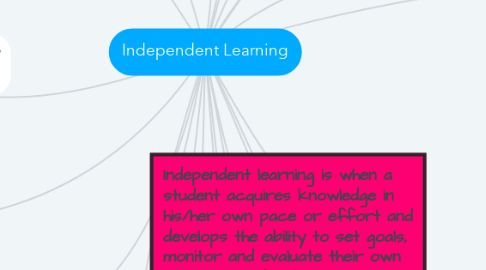Independent Learning
by Hanna Farinah Legaspi


1. Independent learning does not necessarily means working alone
1.1. Independent learning also includes both internal and external factors that will encourage the learners to practice/improve self-monitoring.
2. SKILLS NEEDED: Cognitive, Metacognitive, Affective
2.1. COGNITIVE SKILLS include developing informal rules for problem solving, classifying objects, forming hypothesis, and reasoning logically.
2.1.1. METACOGNITIVE SKILLS include the ability to describe how they learn and the ability to reflect and self-monitor.
2.2. AFFECTIVE SKILLS include motivation and delayed gratification.
3. Element 1. Shift of responsibility for the learning process
3.1. student-centered
4. Element 3: Strong relationship between teachers and students
5. Independent learning is when a student acquires knowledge in his/her own pace or effort and develops the ability to set goals, monitor and evaluate their own learning. Feedback is essential in boosting the confidence of a student. - Josie Cadavos-
6. Element 2: Self-regulation; self-motivation
6.1. Ownership
6.2. Self-Directed
6.3. self-monitor
7. Element 4: enabling physical environment
7.1. - appropriate physical environment - flexible approach to time - shared willingness to undertake independent learning
8. The ICT play an important role in independent learning because it offer opportunities for the easy assessment and measurement of self-directed learning, it increase the speed of access of information, and it provide a medium for interaction between learners and between learners and their teachers.
9. Promotes independence and responsibility among students. It will cater also to the different needs of students and may encourage more students to participate.
9.1. Schools can promote independent learning among students by including support for teachers, study support, empowering to use students self-regulation, and student voice.
10. To promote independent learning, the school should support the teachers, the study support,empower the students to use self-regulation, and the student voice.
11. Independent learning is the ability to monitor and evaluate his/her progress. It also develops and emphasizes creative thinking and problem solving skills which will lead to taking the responsibility of their own learning. Thus, confidence and competence are indeed enhanced. --- Mayette R. Abante
12. Independent learning is a strategy wherein learning is in the hands of the students. It helps the students to develop responsibility for his/her own learning. Learners are able to set goals, make choices, and decide on how to meet his/her own learning needs. - Ryan Alvarez
13. Providing feed back on the student's work and giving reinforcement on their performance helps to promote independent learning and develop their reflective aspect as a metacognition.
14. Teachers can promote independent learning by building a supportive environment, providing students with the opportunity to monitor themselves, and provide feedback on homework to improve confidence.
15. provide the students with opportunities to self-monitor by receiving feedbacks from others and from oneself
16. ACTIVITIES TO ENCOURAGE INDEPENDENT LEARNING:
16.1. 1) Written Feedback
16.1.1. 2) Record and Reflect
16.1.1.1. 3) Feedback Focus
16.1.1.1.1. 4) Confidence Scale
17. CONFIDENCE LEVEL - helps the students think and analyze their learning objective whether they can do it or not and monitor their progress
17.1. FEEDBACK FOCUS - personalizes the learning development by having each students focus on their own objectives
17.1.1. RECORD AND REFLECT - students reflect on their own progress and performances
17.1.1.1. WRITTEN FEEDBACK-it is still important to give teacher's feedback so that student can track their progress , knows what to do next and it also helps to boost their confidence.
